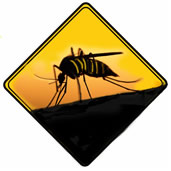COMMUNITY ALERT .....
First detection of the Invasive Mosquitoes
in North County

San Diego - County environmental health officials have found evidence of the Aedes aegypti mosquito, an aggressive, day-feeding invasive mosquito that has the potential to carry serious diseases.
San Diego County vector control officials reported finding Aedes larvae in Escondido, after responding to a resident’s complaint. It’s the first detection of the insect in North County.
County officials again urged people to check inside and outside their homes, apartments and properties and to empty out any standing water where these small, black-with-white-striped mosquitoes can breed.
“It’s very important that we get the public to help fight to keep this mosquito out of the county by eliminating standing water,” said County Environmental Health Director Elizabeth Pozzebon. “This includes inside your home. This mosquito will live and breed indoors.”
The diseases the Aedes mosquito is known for carrying are not native to San Diego County and are rarely seen here unless travelers contract them elsewhere and return home.
Despite that, environmental and public health officials are working to keep the Aedes mosquito — also known as the yellow fever mosquito — from establishing itself here because it can carry serious diseases including yellow fever, dengue and chikungunya.
County officials said they have not discovered how the mosquito had spread from South County to North County, but that it was likely transported by people in cars or material being moved. Officials said Aedes mosquitoes do not spread rapidly on their own.
The Aedes mosquito is fairly easy to identify. That’s because it differs from most native San Diego County mosquitoes in several important ways:
- It usually feeds during the day and is an aggressive biter. Most native mosquitoes prefer to feed between dusk and dawn.
- It likes to live in urban areas — feeding and laying eggs not only outside, but inside people’s homes in almost anything that can contain water, including plant saucers, cups and flowerpots.
-It is small and black with white stripes.
County vector control teams have been putting up and monitoring traps for the Aedes mosquito in the areas where it has been found and handing out information to urge the public to be on the lookout for the pest.
-------------------------------------------------------------------------------
( Photo: Beautiful Dixon Lake in Escondido- San Diego North County)
|